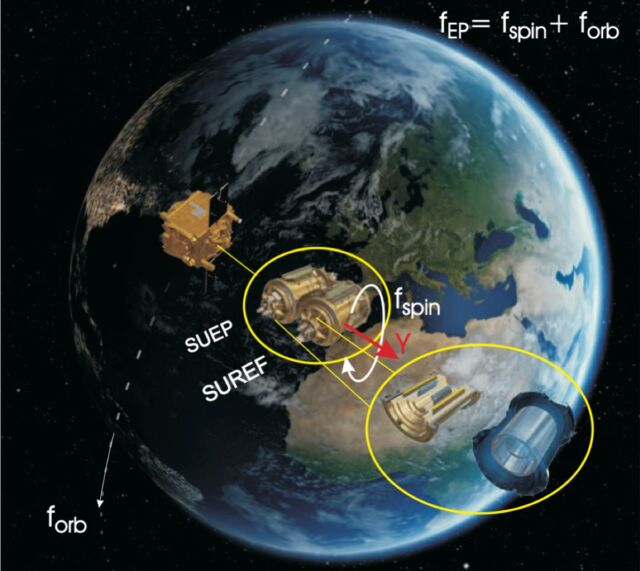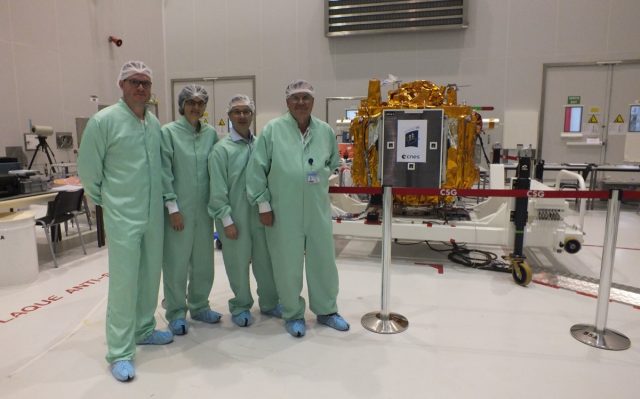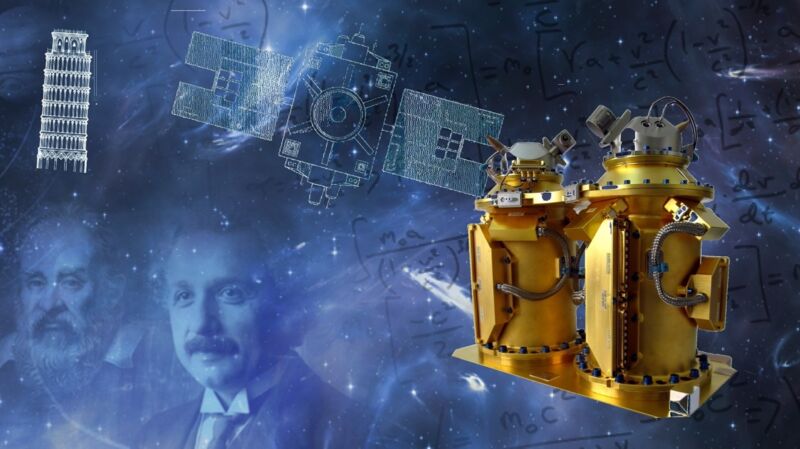One of the most counter-intuitive notions in physics is that all objects fall at the same rate, regardless of mass, aka the equivalence principle. This was memorably illustrated in 1971 by NASA Apollo 15 astronaut David Scott during a moonwalk.
He dropped a falcon feather and a hammer at the same time via a live television feed, and the two objects hit the dirt simultaneously.
There's a long tradition of experimentally testing the weak equivalence principle, which forms the basis of Albert Einstein's general theory of relativity. In test after test over many centuries, the equivalence principle has held strong. And now the MICROSCOPE (MICROSatellite pour l'Observation de Principe d'Equivalence) mission has achieved the most precise test of the equivalent principle to date, confirming Einstein yet again, per a recent paper published in the journal Physical Review Letters. (Additional related papers appeared in a special issue of Classical and Quantum Gravity.)
Testing, 1,2,3
John Philoponus, the 6th-century philosopher, was the first to contend that the velocity at which an object will fall has nothing to do with its weight (mass) and later became a major influence on Galileo Galilei some 900 years later. Galileo supposedly dropped cannonballs of varying masses off Italy's famed Leaning Tower of Pisa, but the story is probably apocryphal.
Galileo did roll balls down inclined planes, which ensured the balls rolled at much lower speeds, making their acceleration easier to measure. The balls were similar in size, but some were made of iron, others of wood, making their masses different.
Lacking an accurate clock, Galileo reportedly timed the balls' travel with his pulse. And like Philoponus, he found that no matter what the incline, the balls would travel at the same rate of acceleration.
Galileo later refined his approach using a pendulum apparatus, which involved measuring the oscillation period of pendulums of different mass but identical length. This was also the method favored by Isaac Newton circa 1680, and later, in 1832, by Friedrich Bessel, both of whom vastly improved the accuracy of the measurements. Newton also realized that the principle extended to celestial bodies, calculating that the Earth and Moon, as well as Jupiter and its satellites, fall toward the Sun at the same rate. The Earth has a core of iron, while the Moon's core is mostly made of silicates, and their masses are quite different. Yet NASA's laser lunar ranging experiments have confirmed Newton's calculations: they do indeed fall around the Sun at the same rate.
Toward the end of the 19th century, Hungarian physicist Loránd Eötvös combined the pendulum approach with a torsion balance to create a torsion pendulum and used it to conduct an even more accurate test of the equivalence principle. That simple straight stick proved accurate enough to test the equivalence principle even more precisely. Torsion balances have also been employed in subsequent experiments, such as the one in 1964 that used chunks of aluminum and gold as the test masses.

Einstein cited the Eötvös experiment verifying the equivalence principle in his 1916 paper laying out the foundation for his general theory of relativity. But general relativity, while it works quite well at the macroscale, breaks down at the subatomic scale, where the rules of quantum mechanics kick in. So physicists have been looking for violations of equivalence at those quantum scales. That would be evidence of potential new physics that could help unify the two into one grand theory.
One method of testing equivalence at the quantum scale is to use matter-wave interferometry. It's related to the classic Michaelson-Morley experiment attempting to detect the movement of the Earth through a medium called the luminiferous aether, which physicists at the time believed permeated space. In the late 19th century, Thomas Young used such an instrument for his famous double-slit experiment to test whether light was a particle or a wave—and as we now know, light is both. The same holds true for matter.
Prior experiments using matter-wave interferometry measured the free fall of two isotopes of the same atomic element, hoping in vain to detect minute differences. In 2014, a team of physicists thought that perhaps there was not a sufficient difference between their compositions to achieve the utmost sensitivity. So they used isotopes of different elements in their version of those experiments, namely rubidium and potassium atoms. Laser pulses ensured the atoms fell along two separate paths before recombining. The researchers observed the telltale interference pattern, indicating that equivalence still held to within 1 part in 10 million.

Orbiting bodies, like the MICROSCOPE satellite, are free-falling continuously, making ideal laboratories for precision measurements on scales where violations might occur. Among other advantages, the environment is free from seismic vibrations or variations in the gravitational field caused by changes in the terrain (like nearby mountains). The satellite carries two electrostatic accelerometers, and within each of those are a pair of cylinders: one small one, nestled inside a larger one. The cylinders are made of the same materials in one accelerometer, and of different materials in the other.
Per the equivalence principle, this should have no effect on how gravity acts upon both cylinders. So if MICROSCOPE measured any deviations, equivalence would be violated. The MICROSCOPE team published preliminary results in 2017, showing no signs of violation at a sensitivity of one part in 1014 over the two and a half years the experiment was in orbit. Now they have analyzed the data even further, confirming those 2017 results and improving the precision to one part in 1015.
A new generation of experiments is proposed for MICROSCOPE 2 that should further improve the level of precision. As Phillipe Brax observed at APS Physics:
Physicists hope that eventually these precision experiments will uncover violations that can lead to new physical theories to explain dark matter or dark energy. Evidence for dark matter and dark energy comes from large-scale observations, such as those of the cosmic microwave background and distant supernovae. Future galaxy surveys will test different cosmological models by probing the way that galaxies “fall” toward each other as they cluster. We can seriously envisage that dark matter and dark energy could be explained in the future by a modification of general relativity at cosmic scales. And thanks to the unity of physics on all scales, we expect that such a modification should eventually be detectable at smaller scales in the form of a violation of the equivalence principle in laboratory and satellite experiments.
Source: Ars Technica






Recommended Comments
There are no comments to display.
Join the conversation
You can post now and register later. If you have an account, sign in now to post with your account.
Note: Your post will require moderator approval before it will be visible.